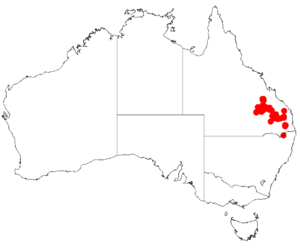Leichhardt's wattle facts for kids
Quick facts for kids Leichhardt's wattle |
|
|---|---|
| Scientific classification | |
| Genus: |
Acacia
|
| Species: |
leichhardtii
|
 |
|
| Occurrence data from AVH | |
Leichhardt's wattle (its scientific name is Acacia leichhardtii) is a type of shrub. It belongs to the Acacia family, which is also known as the wattle family. This plant grows naturally only in north-eastern Australia.
What Does Leichhardt's Wattle Look Like?
This shrub usually grows to about 3 metres (10 feet) tall. It often spreads out wide. Its thin branches usually curve downwards. The smaller branches are covered in soft hairs.
Leichhardt's wattle has small, grey-green leaves called phyllodes. These phyllodes are narrow and shaped like an oval or a spear. They are smooth and mostly straight. Each phyllode is about 1.5 to 3 centimetres long (0.6 to 1.2 inches) and 3 to 6 millimetres wide (0.1 to 0.2 inches). They have a clear line down the middle.
The plant has sweet-smelling flowers. These flowers grow in groups of 12 to 20. Each flower head is round and bright golden. It contains 20 to 40 tiny flowers. After the flowers bloom, hairy seed pods grow. These pods are narrow and can be straight or curved. They can be up to 10 centimetres (4 inches) long and about 9 millimetres (0.35 inches) wide. Inside the pods are black seeds, which are about 5 to 6 millimetres (0.2 inches) long.
Who Discovered Leichhardt's Wattle?
The first official description of Leichhardt's wattle was made by a botanist named George Bentham. He described it in 1864 in his book Flora Australiensis.
Later, in 1987, another botanist named Leslie Pedley changed its scientific name to Racosperma leichhardtii. But in 2001, it was changed back to its original name, Acacia leichhardtii.
Where Does Leichhardt's Wattle Grow?
Leichhardt's wattle is found only in a specific part of Queensland, Australia. It grows from the Central Highlands Region in the north, specifically on the Blackdown Tablelands. It extends south-east to the area around Toowoomba on the Darling Downs.
This plant prefers to grow on sandstone hills. It likes shallow, rocky, sandy soils. You can often find it growing among open Eucalyptus trees in woodland areas.

